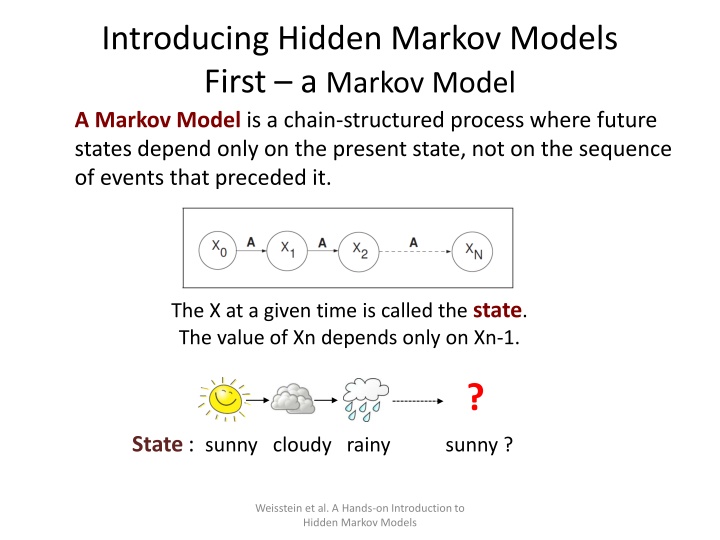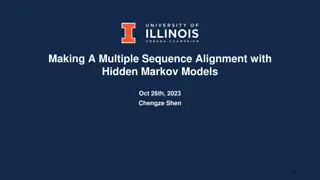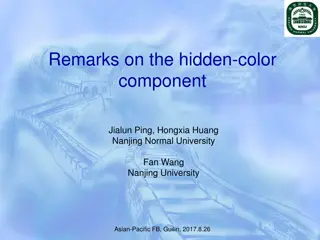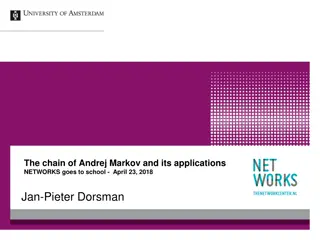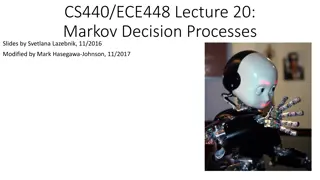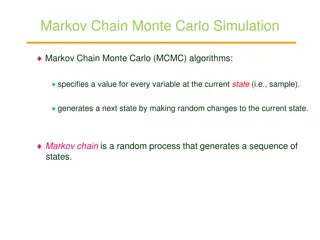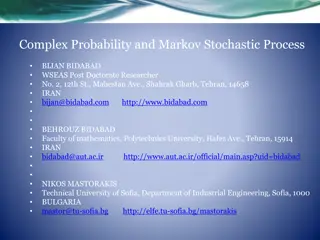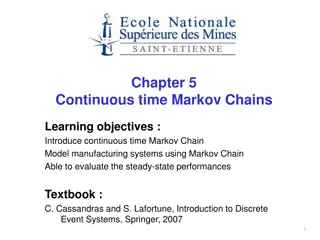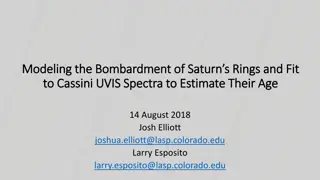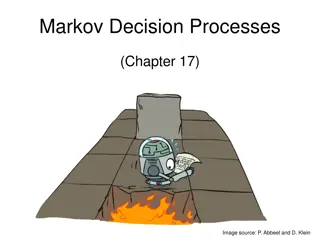Introduction to Markov Models and Hidden Markov Models
A Markov model is a chain-structured process where future states depend only on the present state. Hidden Markov Models are Markov chains where the state is only partially observable. Explore state transition and emission probabilities in various scenarios such as weather forecasting and genetic sequence analysis.
Download Presentation

Please find below an Image/Link to download the presentation.
The content on the website is provided AS IS for your information and personal use only. It may not be sold, licensed, or shared on other websites without obtaining consent from the author.If you encounter any issues during the download, it is possible that the publisher has removed the file from their server.
You are allowed to download the files provided on this website for personal or commercial use, subject to the condition that they are used lawfully. All files are the property of their respective owners.
The content on the website is provided AS IS for your information and personal use only. It may not be sold, licensed, or shared on other websites without obtaining consent from the author.
E N D
Presentation Transcript
Introducing Hidden Markov Models First a Markov Model A Markov Model is a chain-structured process where future states depend only on the present state, not on the sequence of events that preceded it. The X at a given time is called the state. The value of Xn depends only on Xn-1. ? State: sunny cloudy rainy sunny ? Weisstein et al. A Hands-on Introduction to Hidden Markov Models
The Markov Model 90 % sunny 10% rainy ? State : sunny sunny rainy sunny State transition probability (table/graph) (The probability of tomorrow s weather given today s weather) Output format 1: Output format 2: Today Tomorrow Probability sunny rainy sunny sunny 0.9 sunny 0.9 0.1 sunny rainy 0.1 rainy 0.3 0.7 rainy sunny 0.3 rainy rainy 0.7 0.1 Output format 3: 0.7 0.9 0.3 Weisstein et al. A Hands-on Introduction to Hidden Markov Models
The Markov Model 80 % sunny 15% cloudy 5% rainy ? State : sunny cloudy rainy sunny State transition probability (table/graph) Output format 1: Output format 3: Today Tomorrow Probability 0.5 sunny sunny 0.8 sunny rainy 0.05 sunny cloudy 0.15 0.3 0.15 rainy sunny 0.2 rainy rainy 0.6 0.2 0.2 rainy cloudy 0.2 0.05 0.8 cloudy sunny 0.2 0.6 cloudy rainy 0.3 0.2 cloudy cloudy 0.5 Weisstein et al. A Hands-on Introduction to Hidden Markov Models
The Hidden Markov Model A Hidden Markov Model is a Markov chain for which the state is only partially observable. A Markov Model A Hidden Markov Model Hidden states : the (TRUE) states of a system that can be described by a Markov process (e.g., the weather). Observed states : the states of the process that are `visible' (e.g., umbrella). Weisstein et al. A Hands-on Introduction to Hidden Markov Models
The Hidden Markov Model sunny rainy cloudy sunny 0.8 0.05 0.15 rainy 0.2 0.6 0.2 sum to 1 cloudy 0.2 0.3 0.5 State transition probability table Hidden States Observed States The probability of observing a particular observable state given a particular hidden state State emission probability table sunglasses T-shirt umbrella Jacket sunny 0.4 0.4 0.1 0.1 rainy 0.1 0.1 0.5 0.3 sum to 1 cloudy 0.2 0.3 0.1 0.4 Weisstein et al. A Hands-on Introduction to Hidden Markov Models
The Hidden Markov Model exon 5 SS intron The probability of switching from one state type to another (ex. Exon - Intron). exon 0.9 0.1 0 5 SS 0 0 1 sum to 1 intron 0 0 0.9 State transition probability table Hidden States Intron? Exon? Exon? 5 ? SS? The probability of observing a nucleotide (A, T, C, G) that is of a certain state (exon, intron, splice site) Observed States G C T A State emission probability table A C G T exon 0.25 0.25 0.25 0.25 5 SS 0 0 1 0 sum to 1 intron 0.4 0.1 0.1 0.4 Weisstein et al. A Hands-on Introduction to Hidden Markov Models
The Hidden Markov Model Emission Probabilities A = 0.25 C = 0.25 G = 0.25 T = 0.25 A = 0 C = 0 G = 1 T = 0 A = 0.4 C = 0.1 G = 0.1 T = 0.4 Start Exon 5 SS Intron Stop 1.0 0.1 1.0 0.1 0.9 0.9 Transition Probabilities Weisstein et al. A Hands-on Introduction to Hidden Markov Models
Splicing Site Prediction Using HMMs Sequence: C T T G A C G C A G A G T C A 4.519e-13 P2 P3 P4 State path: To calculate the probability of each state path, multiply all transition and emission probabilities in the state path. Emission = (0.25^3) x 1 x (0.4x0.1x0.1x0.1x0.4x0.1x0.4x0.1x0.4x0.1x0.4) Transition = 1.0 x (0.9^2) x 0.1 x 1 x (0.9^10) x 0.1 State path = Emission x Transition = 1.6e-10 x 0.00282 = 4.519e-13 The state path with the highest probability is most likely the correct state path. Weisstein et al. A Hands-on Introduction to Hidden Markov Models
Identification of the Most Likely Splice Site Sequence: C T T G A C G C A G A G T C A 4.519e-13 P2 P3 P4 State path: The likelihood of a splice site at a particular position can be calculated by taking the probability of a state path and dividing it by the sum of the probabilities of all state paths. likelihood of a splice site in state path #1 4.519e-13 = 4.519e-13 + P2 + P3 + P4 Weisstein et al. A Hands-on Introduction to Hidden Markov Models
HMMs and Gene Prediction (color -> state) Weisstein et al. A Hands-on Introduction to Hidden Markov Models
HMMs and Gene Prediction The accuracy of HMM gene prediction depends on emission probabilities and transition probabilities. Emission probabilities are calculated based on the base composition in that particular state in the training data. Transition probabilities are calculated based on the average lengths of that particular state in the training data. Exon length boxplots (DEDB, Drosophila melanogaster Exon Database) Homework Question: How do transition probabilities affect the length of predicted ORFs? Weisstein et al. A Hands-on Introduction to Hidden Markov Models
Conclusions Hidden Markov Models have proven to be useful for finding genes in unlabeled genomic sequence. HMMs are the core of a number of gene prediction algorithms (such as Genscan, Genemark, Twinscan). Hidden Markov Models are machine learning algorithms that use transition probabilities and emission probabilities. Hidden Markov Models label a series of observations with a state path, and they can create multiple state paths. It is mathematically possible to determine which state path is most likely to be correct. Weisstein et al. A Hands-on Introduction to Hidden Markov Models
